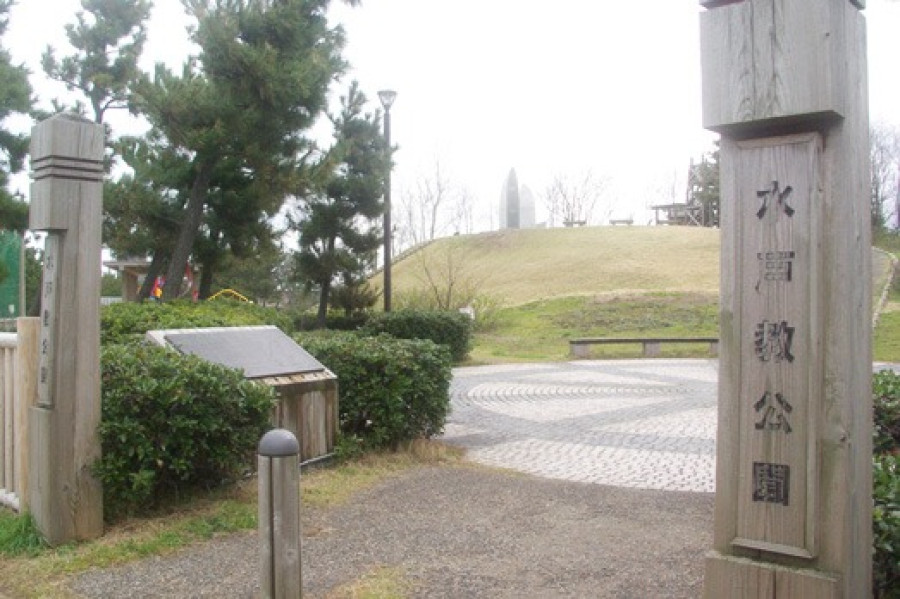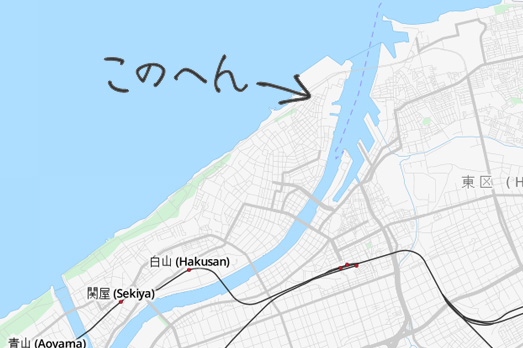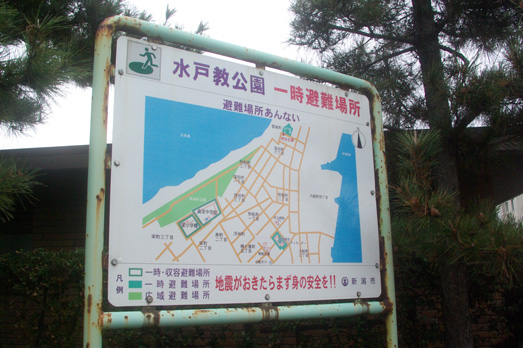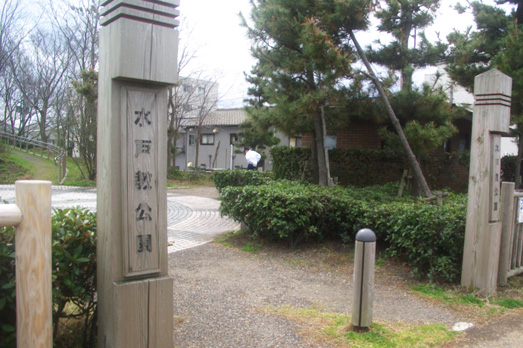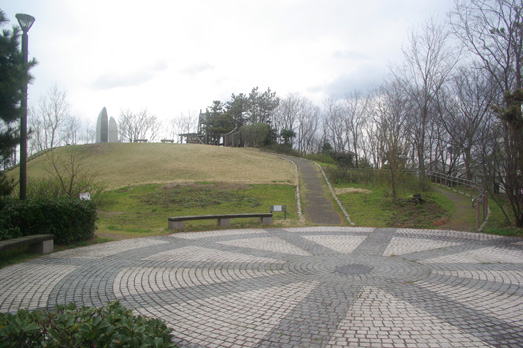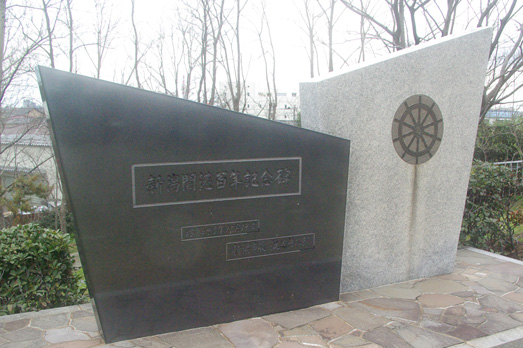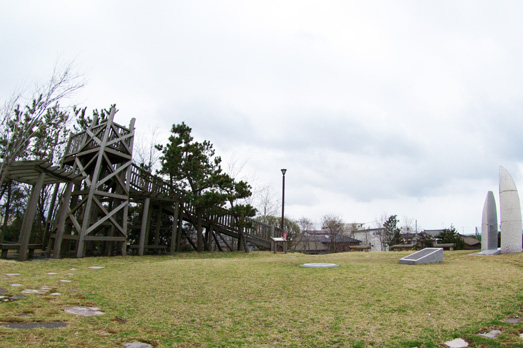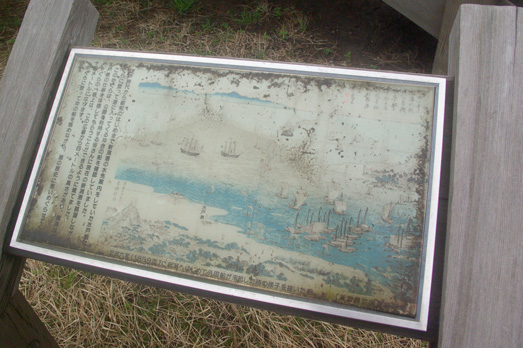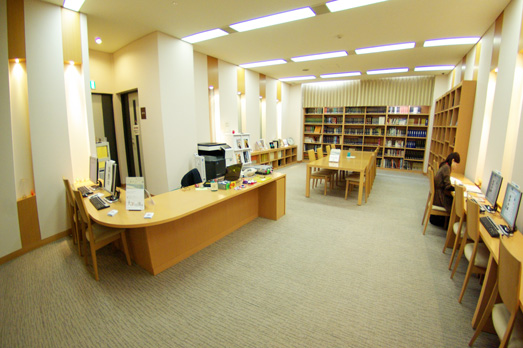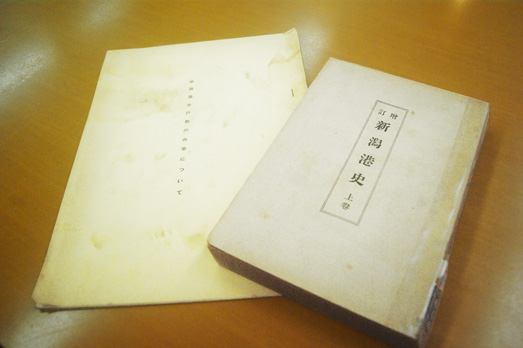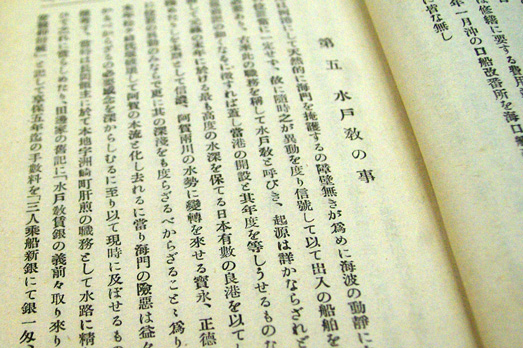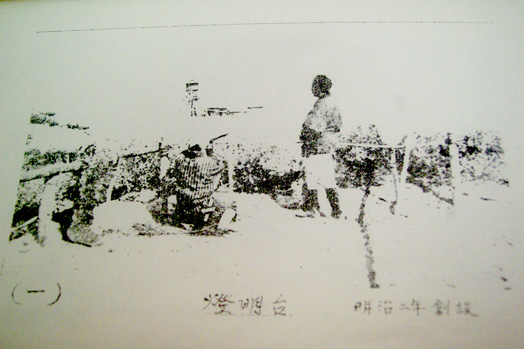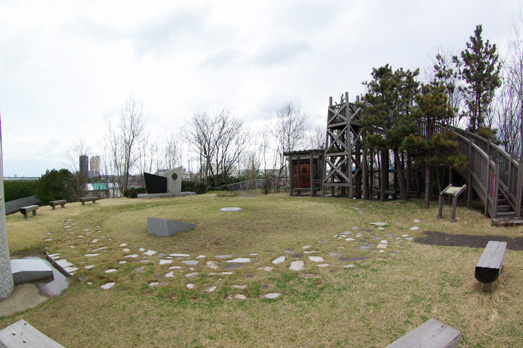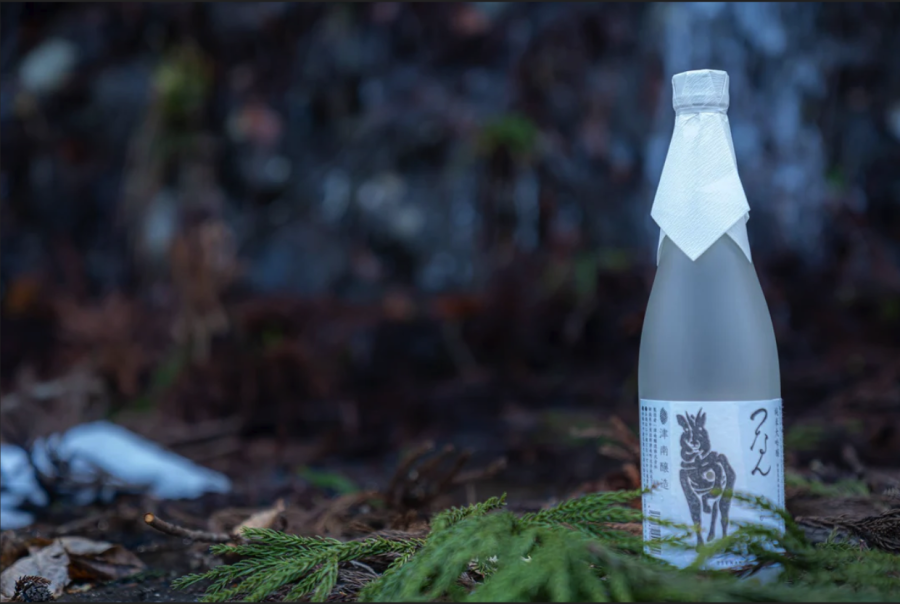Have you ever heard of 'Mito Kyo'?
In fact, there is a park in Niigata City called 'Mito Kyo Park'. Is it a 'Mito Kyo' ・・・・ religion? But I've never heard of 'Mito Kyo'.
Ever since I first found the words "Mito Kyoko Park" on a map, I have been curious about it. So I actually went there.
Anyway, I went to 'Mito Kyo'.
According to the map, Mito Kyoen is located in Chuo Ward, Niigata City, at the tip of the so-called 'Niigata Island'.
The park was located in a quiet residential area near the Minato Tunnel, in a slightly secluded location.
What kind of park is it? Is it a place to hold some kind of ritual?
With a lot of imagination, they walk towards a park at the end of a residential street.
The first thing that came into view was, unsurprisingly, a 'shelter-in-place annai' sign.
... It is an information board that can be found in neighbourhood parks. It looks like a normal park, except for the name.
Entrance to the park. The wooden but magnificent gateposts are inscribed with the words 'Mito Kyoen Park' in large letters.
Apart from one jogger in the park, the park does not seem particularly popular.
There was a monument.
We went into the park. There is a small hill and something like a monument can be seen.
As we approached, we found an explanatory note on a stone tablet. This monument was a 'peace monument' set up by Niigata City.
In the 50th year after the end of the war, the City of Niigata set up a memorial in this park overlooking Niigata Harbour as a prayer for peace.
Another stone monument stands opposite this 'Peace Monument'.
This is the 'Niigata Port Opening Centenary Monument'. It was built in 1968, the centenary of the opening of the port of Niigata to foreign countries in the first year of Meiji.
The mysterious turrets (yagura) and the true identity of 'Mito Kyo'!
And there is another large wooden structure on this hill.
It looks like a slide, but it is not. It has a gentle staircase to the top.
Observatory? A turret (yagura)? like.
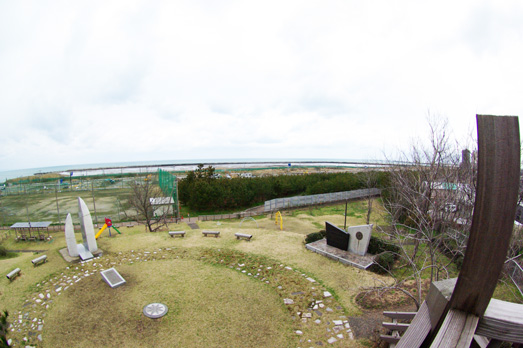 櫓(やぐら)の上まで登ってみました。海が見渡せて、見晴らしがすごく良かったです。
櫓(やぐら)の上まで登ってみました。海が見渡せて、見晴らしがすごく良かったです。
It looks like a normal park, with a monument, an observation tower and a bit of playground equipment. What really is 'Mito Kyo'?
There was an information board under the turret (yagura).
From the Edo period until the beginning of the Showa period, the pilotage of Niigata harbour was conducted by Mito Kyo, who climbed the yagura to check on offshore vessels entering the harbour. (From the information board)
'Piloted Mito Kyo'... Piloted? A further mystery.
However, there was actually an information board at the park entrance as well. This one was a little more detailed.
According to an information board entitled 'The origin of Mito Kyōkō Park'.
In the Edo period, the word 'Mito' meant 'port' or 'estuary'.
There are,
Pilots are needed to guide boats safely to shore. In Niigata, these pilots were called "mizuto-kyo" (water teachers).
They say that the
I see, so 'Mito Kyo' was not a religion, but a port watchman in the Edo period.
Moreover, this 'Mito Kyo' ended its history in the Showa era. It existed until relatively recently.
I see, I see... So what kind of people served in this 'Mito Kyo'? What kind of missions did they have? I began to wonder about such things as.
I would like to know more about 'Mitoism'!
So I visited the Niigata City Museum of History Minatopia, which is located very close to the 'Mito Kyoen' park.
The Minatopia is currently holding the 'Great Niigata Minato Exhibition', and I thought there might be some related exhibits, but there were none, including in the permanent exhibition, particularly related to 'Mito Kyo'.
However, there is actually a room called 'Information Library' in the 'Minatopia'.
Various local books are housed here and can be browsed freely. When you have questions or doubts about the exhibition, you can come to this room and the curators will advise you.
So, when I said here, 'I would like to see more information about Mito Kyo and Mito Kyo Park', he produced two books from the storeroom at the back.
One volume is The History of Niigata Port, Vol. 1. Published in the Taisho era (1912-1926), this is a compilation of the history of Niigata Port and includes descriptions of "Mito Kyo". The descriptions of Mito Kyo in subsequent editions of the 'History of Niigata City' and other publications were based on the contents of this 'History of Niigata Port'. The Mito Kyo' is described on page 4.
However, as this book was published in the Taisho era, it is written in the old kana script, and even though it is only four pages long, it would take some time to read this.
The other booklet is 'On the origin of the Niigata Port Mito Kyo'. This is a booklet of about six pages in total. The year of publication is not stated, but from the text it seems to date from around 1967. This one was in modern kana usage.
'Mito Kyo' was a venerable position that continued to support Niigata's development behind the scenes!
The following is a rough summary of the contents of these two books.
Niigata's ports began to flourish in the Edo period.
The wholesalers therefore decided to appoint a full-time "boat watchman". Nitaro, who was a fisherman at the time, was appointed to this post, and from then on, Nitaro's descendants have been in this position for generations.
In Kyoho 16, 283 years ago, the Shinano and Agano rivers, which had previously joined at the mouth of the river, were separated. As a result, the Niigata harbour became difficult for large vessels to enter and leave because the river bottom became shallow.
A full-time "pilot" was therefore appointed, and this was to be Nitaro, who was familiar with the harbour entrance.
This position was called 'Mito Kyo'. This was roughly 230 years ago.
Nitaro took the surname Ito, and held the position of Mito Kyo as 'Ito Nitaro' for generations.
The mission of its 'Mito Kyo' is described as follows.
Every day, he climbed Mt Hiyori to watch the sun, watch the ships, measure the depth of the harbour entrance every day, and guide ships in and out of the harbour. When he found a ship about to be wrecked due to bad weather, he rescued the ship at his own peril to ensure safe navigation at the harbour entrance.
Incidentally, Nitaro Ito also had several subordinates.
Every day, you not only had to watch the boats, but also measure the depth of the water, and you also had to risk your life. The 'Mito Kyo' supported the development of the port city of Niigata behind the scenes.
This should already be featured on NHK's Time Scoop Hunter ( http://www.nhk.or.jp/timescoop/ ).
'Mitoism' since the Meiji era.
From the mid-Edo period to the end of the Edo period, earth and sand carried from the Shinano River accumulated at the port entrance of Niigata, and the port became distant from the 'Hiyoriyama' where the 'Mito Kyo' had previously been packed. For this reason, a 'Funami-Banjo-ya' was built around the time of the Tempo era, and a 'Nitaro-ya' around the end of the Edo period and the beginning of the Meiji era, where it seems that they performed their duties.
This is a photograph of 'Mito Kyo' Ito Nitaro, believed to date from the early Meiji era. The figure on the left is Nitaro, looking at the harbour entrance through a pair of magnifying glasses. The figure on the right is believed to be one of Nitaro's subordinates.
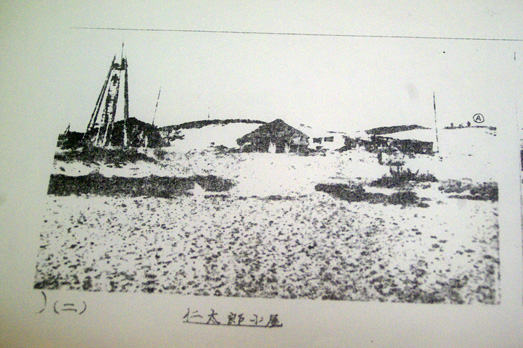 こちらも明治初年のものとされる「仁太郎小屋」の写真です。左側に見えるのが「船見櫓」でしょうか。
こちらも明治初年のものとされる「仁太郎小屋」の写真です。左側に見えるのが「船見櫓」でしょうか。
After the Restoration, 'Mito Kyo' went through twists and turns, and in 1878 'Mito Kyo' continued to exist as a public enterprise.
From the Taisho period to the beginning of the Showa period, as the port of Niigata was modernised and the water depth stabilised, the 'Mito Kyo', which had been in existence for 140 years, was discontinued. Thereafter, pilotage services were operated directly by the prefecture, and the 'Pilots' Association', which took on this task, took over the facilities of the 'Mito Kyoko'. However, in 1964, a fire destroyed the Mito Kyoko building, along with the surrounding pine forest.
After that, it seems to have been an empty sand dune for some time. Later, to commemorate the footsteps of 'Mito Kyo', the Mito Kyo Park was built on a site overlooking Niigata Harbour. (From the information board of Mito Kyo Park)
So, at first glance, Mito Kyoen Park may look like an ordinary park, but it was a fascinating spot from which the history of the town of Niigata could be felt clearly.
Yet, it is also a rather nice park with a quiet and nice view. Nearby you will also find the Minato Tower, Hiyoriyama Shrine, the birthplace of 'Mito Kyo', and Minatopia. Why not visit this park at the tip of Niigata Island on a sunny holiday?
Spotlight.
Mito Teaching Park
- Address: 18, Hibari-cho, Chuo-ku, Niigata City, Niigata Prefecture.
Minatopia, Niigata City Museum of History
- Address: 2-10, Yanagishima-cho, Chuo-ku, Niigata City, Niigata Prefecture
- Opening hours: main museum building Apr-Sept 9.30-18.00.
- Website: http: //www.nchm.jp/
advertisement


